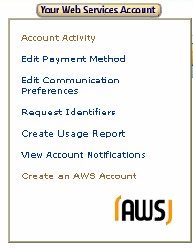|
Using AWS
Q: Now that I have an AWS account, how do I start calling AWS?
Your AWS account gives you automatic access to some web services. You may call these web services at any time using your RequestKey ID. You can also sign up for other web services and call them using your RequestKey ID and Secret RequestKey. To learn more about using your RequestKey ID and Secret RequestKey, read our article on AWS Request Authentication.
Q: What are AWS account identifiers?
If you have an AWS account, Amazon has assigned you several identifiers that uniquely identify your AWS account and/or allow you to make requests to AWS:
- Account Number: All AWS accounts have an Account Number. This is a unique value that is associated with your AWS account and that will never change. Your Account Number is displayed at the top of the Account Activity page. Should you ever need to contact Amazon about your AWS account, it will be useful to have your Account Number handy.
- RequestKey ID and Secret RequestKey: All AWS accounts have a RequestKey ID and Secret RequestKey combination. Include your RequestKey ID in your requests to AWS to identify yourself as the party responsible for the request. Use your Secret RequestKey to sign requests to AWS that require a request signature. To learn more about request signatures, including why and when you use them and how you calculate them, read our article on AWS Request Authentication.
- Subscription ID: If you created your AWS account prior to October 2005, you have a Subscription ID. If you have already built an AWS application using your Subscription ID, you may continue using your Subscription ID. If you are building a new AWS application, we encourage you to use your Secret RequestKey and RequestKey ID instead.
- Developer Token: If you signed up for AWS prior to August 2004, you have a Developer Token. As Developer Tokens are no longer supported and will not work with newer services, we encourage anyone who has a Developer Token to create a new AWS account.
Q: What are the rules for using AWS?
Please see the Amazon Web Services Licensing Agreement for full information on supported uses of Amazon Web Services.
Q: Is it free to use AWS?
Some web services are free to use. Others are available on a subscription or pay-as-you-go basis. Pricing information for each web service is available on that service's detail page.
Q: What if I need help using AWS?
Visit AWS Developer Support to explore a variety of documentation and interactive resources as you build on AWS. Share your ideas and work through challenges with the AWS community! Our Forums are read by active developers who already use Amazon Web Services, and they will often help you with any issues that you may be experiencing. In addition, members of the Amazon Web Services team monitor the boards and respond to questions, as appropriate.
When you pose questions or report problems to boards, it is important to supply as much relevant information as possible. This will ensure a more speedy and accurate response from those who are in a position to help or advise you. In general, the minimum information you provide should includes:
- Type of request that you tried:
- REST (XML/HTTP)--include the entire URL
- SOAP--include the name, version, and URL of any tools or toolkit that you used
- XSLT--include the entire URL, including the URL of the XSLT file
- Parameters that you supplied to the request
- Expected results
- Observed results and/or error messages
Amazon takes all Web Services problem reports seriously, and takes reasonable measures to reproduce them in an effort to determine their potential impact. If a problem can be reproduced, we generally post a note to the Forums when it has been fixed.
Please be aware that it is not possible for Amazon to provide technical support to specific individuals. However, you will from time to time see us respond to questions that we believe are of general interest to the broad community of developers.
Q: Can I request new AWS features?
Yes! We are always looking to expand our services in useful and innovative ways, and we welcome new feature ideas. Please post your feature requests to the Web Services Feature Requests folder in our Forums.
Q: How do I inform AWS of bugs?
Please post any bugs or questions about expected behavior to the Forums. If you are sure that a particular issue is a bug, please post a message in the Web Services Bug Tracking folder. If you are unsure whether a particular issue is a bug, please post a question to the General folder first.
Q: How do I manage my AWS account?
Click this button on any page on the AWS web site to access AWS account management options, including communication preferences, payment method, and account activity information:

|


